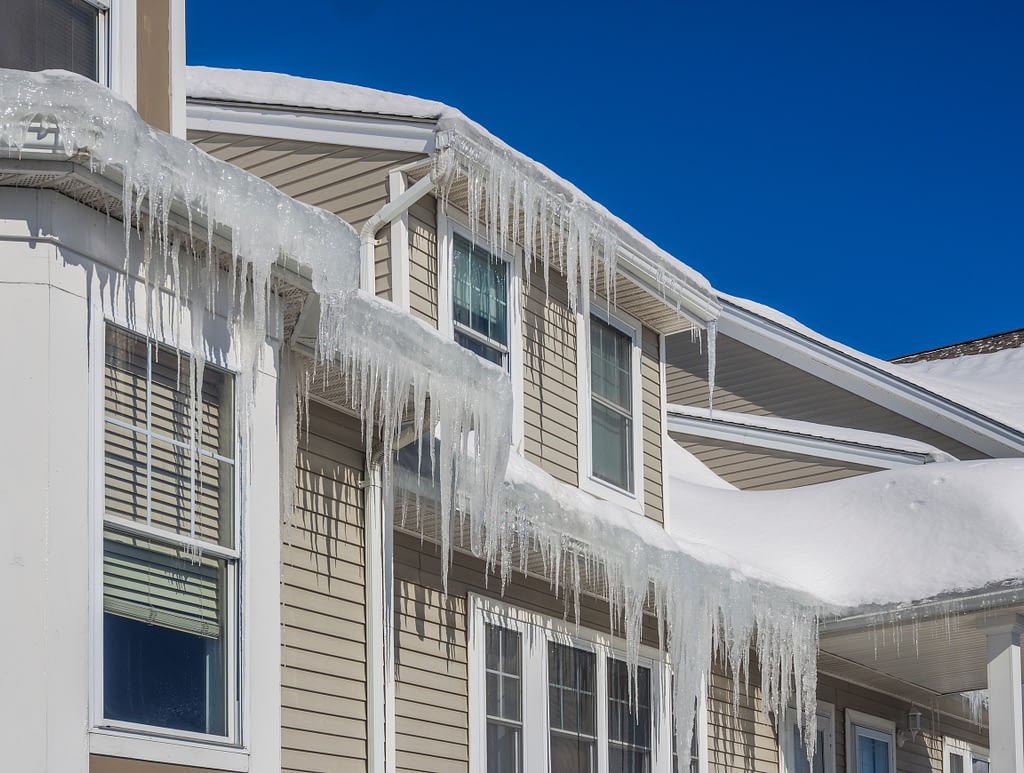During a cold and snowy winter, ice dams can form quickly, staining ceilings and walls, dislodging shingles, decaying structural framing and causing water to back up into your home. According to the Insurance Information Institute, water damage and freezing that can result from ice dams and other winter weather disasters account for almost 20% of all homeowners insurance claims. Know how to spot the signs of ice dams and how to remove them to prevent potential damage to your home during the winter season.
What is an ice dam?
As the sun melts snow sitting on the upper part of your roof and heat rises into your attic, the water flows down to the lower, colder part of your roof. Snow and ice in this area doesn’t melt as quickly, forming melt water pools over the eaves of your roof. Some of this water then refreezes, forming a thin layer of ice. This happens repeatedly, and can cause a thick ice dam that holds back a large pool of water, preventing it from draining off the roof and forcing the water under your shingles, into the attic and down the walls of your home.
How to tell if you have an ice dam
Outside the house, look at your roof. If your gutters are layered with thick ice under the snow, an ice dam has formed. Inside the house, look for water stains or signs of moisture in the attic or along exterior walls. Your roof has an ice dam if there is water leaking from the ceilings or pooling along exterior walls.
How to remove an ice dam
If it’s safe to do so, remove an ice dam as soon as you see it to prevent damage to your home. If you can safely reach the roof, use calcium chloride ice melt to melt the dam yourself. Fill a nylon stocking with calcium chloride ice melt, typically sold at any hardware store. Place the nylon stocking vertically across the ice dam, and it will melt a channel in the dam through which water can flow. Make sure the channels extend all the way to the edge of the roof.
When to bring in a professional
According to Consumer Reports, there were an estimated 1,600 emergency room visits between 2014 and 2016 related to homeowners attempting to remove snow from their roofs without professional help. If you cannot reach the roof safely from the ground or are at all questioning whether you need assistance, contact a professional to remove the ice and snow from your roof. If you see water damage, a restoration service can dry out the walls and ceiling, preventing decay, mold and mildew from forming. Your Forest Insurance agent can help you find a reputable and reliable contractor.
How to prevent future ice dams
- Keep your gutters clean, so melting snow can flow off the roof.
- Monitor your roof in cold weather. Check for icicles, as their presence means the conditions for an ice dam to form are present.
- Use a snow rake to remove snow from your roof or hire a licensed professional snow remover or roofing contractor.
- Use heating cables on eaves and gutters to create channels for water to drain.
- Ensure proper attic ventilation and insulation so warm air doesn’t rise to the attic.
Coverage options that can protect you
Contact your Forest Insurance agent to review your existing insurance coverage protection and determine if you have the proper coverage and limits in place to protect you should an ice dam damage your home.
To review your existing insurance coverage protection and determine if you have the proper coverage and limits in place to protect you should an ice dam damage your home, contact the independent insurance agents at Forest Insurance at (708) 383-9000 and www.forestinsured.com.
Content provided by Hanover Insurance. Visit www.forestinsured.com and www.hanover.com for more information.
![]()
Ice dams and snow on roof and gutters after bitter cold


